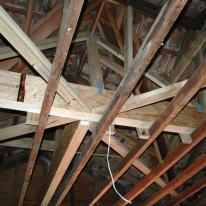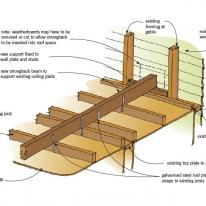Ceiling joists sagging
Listed under: Interior, insulation, timber and wood-based, health and safety, timber, Roof, cladding, roof space, moisture, durability, rot, roof cladding, concrete or clay tiles, leaks, mould, mould health and safety
Cause
Ceiling joist spans too great for the timber size
Repair
-
existing framing of villas is likely to be undersized for the span and timber dimensions when compared to the current version of NZS 3604 Timber-framed buildings
-
one or more strongbacks could be installed (see drawing). These new beams are supported off load-bearing walls to provide support to ceilings (via hangers) and rafters. Jacks may be needed to lift the existing structure back into line before the strongbacks are installed
-
where walls are being removed or having significant repairs, timber, engineered steel beams or LVL (laminated veneer lumber) beams could be used in the ceiling space
-
flitching a new member alongside the existing (and fixing to it) may be possible in some cases
-
depending on the degree of sag in the joists, returning them to an absolutely level position may not be possible. The building owner may find a reduced sag acceptable, but if not, replacement of the timber joist(s) will be required
Cause
Joists have been overloaded
Cause
Poor quality timber
Cause
Cracked or broken timber
Repair
- see the repair options above
Cause
Light roof cladding has been replaced with a heavy roof cladding
Repair
-
where a light roof cladding has been replaced with a heavy one, the roof structure will probably have needed strengthening to take the extra weight. This may not have been done, however, resulting in the sagging joists
-
one or more strongbacks could be installed (see drawing). These new beams are supported off load-bearing walls to provide support to ceilings and rafters. Jacks may be needed to lift the existing structure back into line before the strongbacks are installed
-
where walls are being removed or having significant repairs, timber, engineered steel beams or LVL (laminated veneer lumber) beams could be used in the roof space
-
flitching a new member alongside the existing and fixing to it may be possible in some cases
-
depending on the degree of sag in the joists, returning them to an absolutely level position may not be possible. The building owner may find a reduced sag acceptable, but if not, replacement of the timber joist(s) will be required
Cause
Timber has rotted due to leaks or high roof space moisture
Repair
-
first, identify the cause of the leaks and/or high roof space moisture levels and remedy these
-
high roof space moisture may be the result of high levels of moisture passing into the roof space from the rooms below, for example through the gaps around recessed downlights. If this is the case, reduce moisture in the rooms:
-
install a rangehood over the kitchen stove and an exhaust vent near the shower in the bathroom, and vent both so that they take steam outside the house
-
dispose of unflued gas heaters
-
avoid drying laundry inside
-
open windows wide for at least 10 minutes each day
-
if there are many older-style downlights penetrating the ceiling, replace with more modern tighter-fitting lights (or ceiling-mounted lights)
-
replace damaged joists with new treated (H1.2) timber
Cause
Build up of sand inside roof space in beachside properties with concrete or clay tile roofs
Repair
-
vacuum out the sand. If possible, consider installing a roof underlay to the underside of the rafters to reduce wind flow into the roof space
-
install a strongback across the joists as above
Cause
Internal wall has been removed
Repair
- if a load-bearing internal wall has been removed, consult a registered structural engineer for potential solutions.







